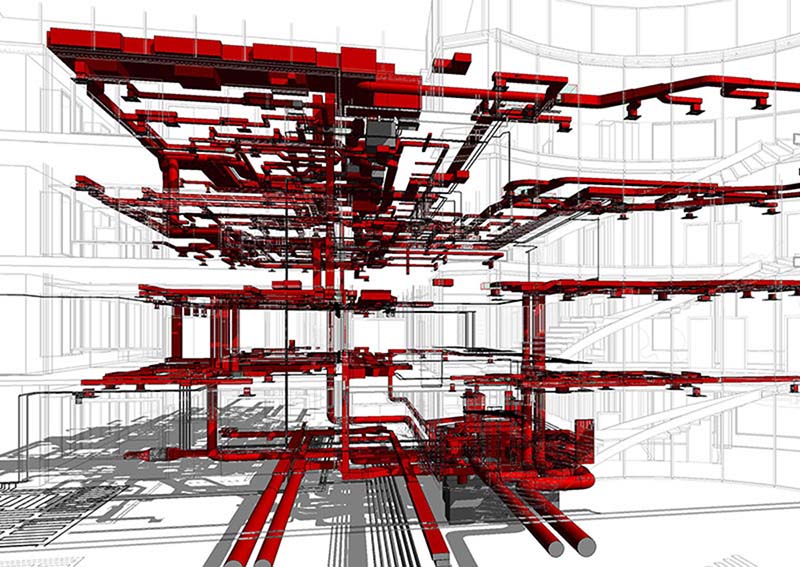In the dynamic landscape of construction and building design, efficiency is paramount. MEP (Mechanical, Electrical, and Plumbing) systems form the backbone of modern buildings, and their effective integration is crucial for project success. Enter MEP BIM (Building Information Modeling) modeling services – a game-changer in the construction industry. In this blog post, we’ll explore how BIM modeling services unlock efficiency, streamline workflows, and revolutionize the way MEP systems are designed, analyzed, and implemented.
Understanding MEP BIM Modeling
MEP BIM modeling is a collaborative process that involves creating digital representations of mechanical, electrical, and plumbing systems within a building’s 3D model. Unlike traditional 2D drawings, MEP BIM models provide a comprehensive and detailed visualization of MEP components, allowing for better coordination, analysis, and communication throughout the project lifecycle. By leveraging advanced BIM software such as Revit, AutoCAD MEP, and Navisworks, BIM modeling services enable stakeholders to visualize, simulate, and optimize MEP systems with unprecedented accuracy and efficiency.
The Power of Integration
One of the key advantages of MEP BIM modeling services is the seamless integration of MEP systems with architectural and structural elements. By working within a unified BIM environment, architects, engineers, and contractors can collaborate more effectively, identify potential clashes and conflicts early in the design process, and make informed decisions to optimize system performance and spatial coordination. The result is a more cohesive and coordinated building design that minimizes rework, reduces costs, and accelerates project delivery.
Efficiency in Design and Coordination
BIM modeling services streamline the design and coordination of MEP systems, allowing for greater efficiency and accuracy in project execution. Through parametric modeling, engineers can quickly generate and modify MEP components, such as ductwork, piping, and electrical conduits, based on project requirements and design constraints. Clash detection tools identify conflicts between MEP systems and other building elements, enabling proactive resolution before construction begins. Additionally, MEP BIM models serve as a central repository of project information, facilitating communication and collaboration among project stakeholders and reducing the likelihood of errors and omissions.
Optimizing Performance and Sustainability
BIM modeling services empower engineers to optimize the performance and sustainability of MEP systems through advanced analysis and simulation tools. Energy analysis software allows engineers to assess the energy efficiency of HVAC systems, lighting design, and building envelope performance, identifying opportunities for energy savings and carbon reduction. Computational fluid dynamics (CFD) simulations enable engineers to evaluate airflow patterns, thermal comfort, and indoor air quality, ensuring optimal performance and occupant comfort. By integrating sustainability principles into the design process, MEP BIM modeling services contribute to the development of greener, more environmentally friendly buildings that meet the needs of today without compromising the needs of future generations.
Case Studies in Efficiency
Let’s explore two real-world case studies that demonstrate the power of BIM modeling services in unlocking efficiency:
Iconic Tower Project
In a high-profile tower project, BIM modeling services played a critical role in coordinating the complex MEP systems of the building. By creating detailed BIM models of mechanical, electrical, and plumbing components, engineers were able to identify clashes and conflicts early in the design process, reducing the risk of rework and delays during construction. Through iterative design iterations and simulation analysis, engineers optimized the performance of HVAC systems, lighting design, and plumbing layouts, resulting in a more efficient and sustainable building.
Large-Scale Commercial Development
In a large-scale commercial development project, MEP BIM modeling services facilitated collaboration among multiple design disciplines and construction teams. By centralizing project information within a shared BIM environment, architects, engineers, and contractors were able to access real-time updates and coordinate their activities more effectively. Clash detection tools helped identify and resolve conflicts between MEP systems and structural elements, minimizing costly errors and delays. Additionally, energy analysis software allowed engineers to assess the environmental impact of design decisions and implement sustainable design strategies that reduced energy consumption and operational costs over the life of the building.
Challenges and Opportunities
While BIM modeling services offer significant benefits, they also present challenges that must be addressed to fully realize their potential. These challenges include
Technical Expertise: Effective implementation of BIM modeling services requires specialized technical skills and expertise in BIM software and workflows. Engineering firms must invest in training and development programs to ensure their staff are proficient in BIM technologies and methodologies.
Data Management: MEP BIM models generate vast amounts of data that must be managed, organized, and maintained throughout the project lifecycle. Engineering firms must establish robust data management protocols and systems to ensure the integrity, security, and accessibility of project information.
Collaboration and Coordination: BIM modeling services require close collaboration and coordination among project stakeholders, including architects, engineers, contractors, and owners. Engineering firms must foster a culture of collaboration and communication to facilitate effective teamwork and decision-making.
Cost and Resources: Implementing BIM modeling services may require upfront investment in software licenses, hardware, and training, which can pose financial challenges for engineering firms, particularly smaller firms
Conclusion
MEP BIM modeling services represent a paradigm shift in the construction industry, offering unparalleled efficiency, accuracy, and collaboration throughout the project lifecycle. ENGISOFT ENGINEERING – BIM Staffing & BIM Services By harnessing the power of digital technology and advanced simulation tools, architectural engineering consultants can optimize the design, coordination, and performance of MEP systems in ways that were previously unimaginable. From reducing clashes and conflicts to optimizing energy efficiency and sustainability, BIM modeling services are transforming the way buildings are designed, constructed, and operated.











